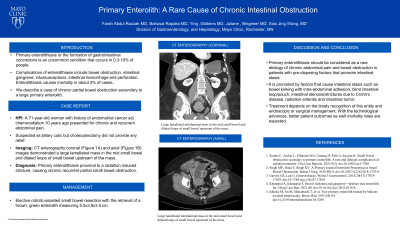Back


Poster Session E - Tuesday Afternoon
Category: Small Intestine
E0660 - Primary Enterolith: A Rare Cause of Chronic Intestinal Obstruction
Tuesday, October 25, 2022
3:00 PM – 5:00 PM ET
Location: Crown Ballroom

Has Audio

Farah Abdul Razzak, MD
Mayo Clinic
Rochester, MN
Presenting Author(s)
Farah Abdul Razzak, MD, Babusai Rapaka, MD, Ying Gibbens, MD, PhD, Juliane Bingener, MD, Xiao Jing (Iris) Wang, MD
Mayo Clinic, Rochester, MN
Introduction: Primary enterolithiasis or the formation of gastrointestinal concretions is an uncommon condition occurring in 0.3-10% of people. It is promoted by factors that cause intestinal stasis such as bowel kinking with intra-abdominal adhesion, blind intestinal loop/pouch, intestinal stenosis/strictures due to Crohn's disease, radiation enteritis and intestinal tumor. Complications of enterolithiasis include bowel obstruction, intestinal gangrene, intussusceptions, intestinal hemorrhage and perforation. Enterolithiasis causes mortality in about 3% of cases. While acute intestinal obstruction is described by a few cases, chronic obstruction has rarely been reported. Here, we describe a case of chronic partial bowel obstruction secondary to a large primary enterolith.
Case Description/Methods: A 71-year-old woman presented to gastroenterology clinic for chronic and recurrent abdominal pain. Her past medical history was significant for endometrial cancer for which she underwent total abdominal hysterectomy and chemo-radiation 10 years prior. She developed post-prandial nausea, vomiting and abdominal pain 5 years ago. The pain was initially thought to be from biliary colic, but cholecystectomy did not provide relief. During the last 6 months, she experienced increasing frequency of stereotypical abdominal pain episodes with nausea and vomiting, Physical exam demonstrated a benign abdomen without tenderness or distention. CT enterography was performed, and the coronal (Figure 1A) and axial (Figure 1B) images demonstrated a large lamellated intraluminal mass in the mid small bowel and dilated loops of small bowel upstream of the mass. The patient was diagnosed with primary enterolithiasis proximal to a radiation induced stricture, causing chronic recurrent partial small bowel obstruction. Two weeks later, she underwent elective robotic-assisted small bowel resection with the retrieval of a brown, green enterolith measuring 5.5x3.8x3.5 cm. The patient was discharged on post-operative day 3 without complications.
Discussion: Primary enterolithiasis should be considered as a rare etiology of chronic abdominal pain and bowel obstruction in patients with pre-disposing factors that promote intestinal stasis. Treatment depends on the timely recognition of this entity and endoscopic or surgical management. With the technological advances, better patient outcomes as well mortality rates are expected.

Disclosures:
Farah Abdul Razzak, MD, Babusai Rapaka, MD, Ying Gibbens, MD, PhD, Juliane Bingener, MD, Xiao Jing (Iris) Wang, MD. E0660 - Primary Enterolith: A Rare Cause of Chronic Intestinal Obstruction, ACG 2022 Annual Scientific Meeting Abstracts. Charlotte, NC: American College of Gastroenterology.
Mayo Clinic, Rochester, MN
Introduction: Primary enterolithiasis or the formation of gastrointestinal concretions is an uncommon condition occurring in 0.3-10% of people. It is promoted by factors that cause intestinal stasis such as bowel kinking with intra-abdominal adhesion, blind intestinal loop/pouch, intestinal stenosis/strictures due to Crohn's disease, radiation enteritis and intestinal tumor. Complications of enterolithiasis include bowel obstruction, intestinal gangrene, intussusceptions, intestinal hemorrhage and perforation. Enterolithiasis causes mortality in about 3% of cases. While acute intestinal obstruction is described by a few cases, chronic obstruction has rarely been reported. Here, we describe a case of chronic partial bowel obstruction secondary to a large primary enterolith.
Case Description/Methods: A 71-year-old woman presented to gastroenterology clinic for chronic and recurrent abdominal pain. Her past medical history was significant for endometrial cancer for which she underwent total abdominal hysterectomy and chemo-radiation 10 years prior. She developed post-prandial nausea, vomiting and abdominal pain 5 years ago. The pain was initially thought to be from biliary colic, but cholecystectomy did not provide relief. During the last 6 months, she experienced increasing frequency of stereotypical abdominal pain episodes with nausea and vomiting, Physical exam demonstrated a benign abdomen without tenderness or distention. CT enterography was performed, and the coronal (Figure 1A) and axial (Figure 1B) images demonstrated a large lamellated intraluminal mass in the mid small bowel and dilated loops of small bowel upstream of the mass. The patient was diagnosed with primary enterolithiasis proximal to a radiation induced stricture, causing chronic recurrent partial small bowel obstruction. Two weeks later, she underwent elective robotic-assisted small bowel resection with the retrieval of a brown, green enterolith measuring 5.5x3.8x3.5 cm. The patient was discharged on post-operative day 3 without complications.
Discussion: Primary enterolithiasis should be considered as a rare etiology of chronic abdominal pain and bowel obstruction in patients with pre-disposing factors that promote intestinal stasis. Treatment depends on the timely recognition of this entity and endoscopic or surgical management. With the technological advances, better patient outcomes as well mortality rates are expected.

Figure: Figure 1: CT enterography showing a large lamellated intraluminal mass in the mid small bowel A) Coronal view, B) Axial view
Disclosures:
Farah Abdul Razzak indicated no relevant financial relationships.
Babusai Rapaka indicated no relevant financial relationships.
Ying Gibbens indicated no relevant financial relationships.
Juliane Bingener indicated no relevant financial relationships.
Xiao Jing (Iris) Wang indicated no relevant financial relationships.
Farah Abdul Razzak, MD, Babusai Rapaka, MD, Ying Gibbens, MD, PhD, Juliane Bingener, MD, Xiao Jing (Iris) Wang, MD. E0660 - Primary Enterolith: A Rare Cause of Chronic Intestinal Obstruction, ACG 2022 Annual Scientific Meeting Abstracts. Charlotte, NC: American College of Gastroenterology.
